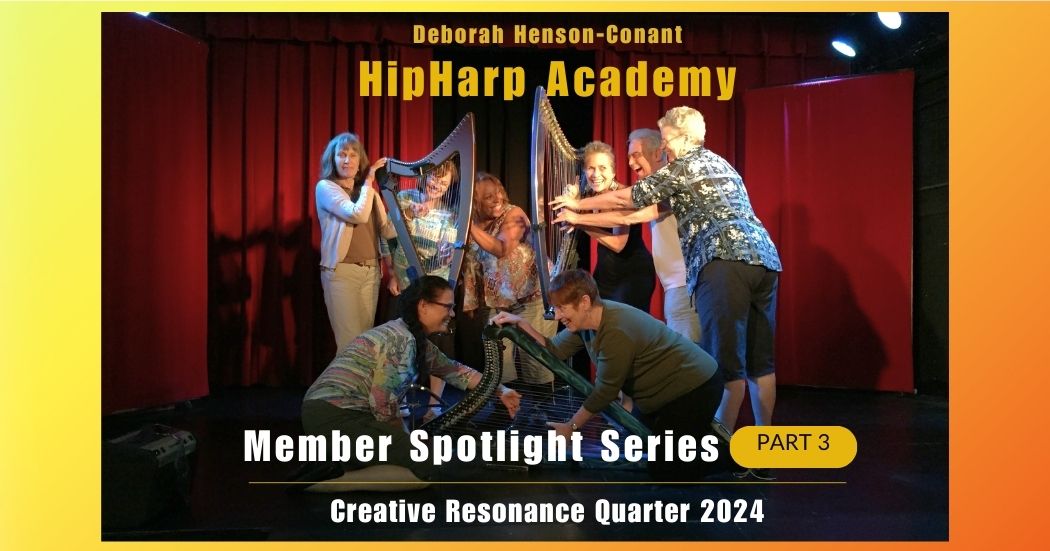
Welcome to Hip Harp Academy Member Spotlight Series: Creative Resonance Quarter (Part 3 of 3)
For this year’s first quarter, Hip Harp Academy Members poured out their creativity to the next level, putting their creative expression into forms so that they can share it with others. And now, I’m sharing them with you!
Scroll down to see the projects – but first, take a moment to think about the power of people sharing their creative PROCESS instead of a PERFECTED “PRESENTATION.” What you’ll learn from these videos – and the mini-interviews in which they share their process – will be far more inspiring to your creativity than someone sharing a trendy video with five gazillion hits. This is creative process – and in these shares, you get to glimpse into the process of other people like you and HOW they overcame their own blocks to accomplish their next creative goal.
The Hip Harp Academy Members’ Final Beginning Project
How to enjoy these wonderful video shares: Enjoy the creativity and the willingness to share. Think about the fact that each of these videos is a unique creation – none of these musicians are playing written sheet music – they’ve created these arrangements by learning the fundamentals of arrangement and improvisation and putting them into play – literally – in their own creations. And notice how different each video and each project is from the others … and yet they were all taking the exact same class.
This is the power of learning the tools of self-expression and creativity.
“Final-Beginning” is a term we use remind ourselves that these are not meant to be “Final” projects. If we worry about making them ‘FINAL’, we’d never share! Instead, we learn to embody a moment of completion as a new beginning: to acknowledge an accomplishment as something that opens up a new door, a new place to stand in, a new level of confidence – not the FINAL – it’s not the END … but the new BEGINNING.
So think about that as you watch them and read their own account of their personal creative journey in creating each video by clicking the toggle beneath each video – and I encourage you to do that if you really want to be inspired.
Some of the players have played for years, and even decades – some have come to the harp as adults – some even as a retirement gift for themselves. We’re a community connected by a commitment to creative expression. Every week we meet for masterclasses and training, and during the week we practice the new ideas and the willingness to be vulnerable, authentic and self-expressed with our instruments, our voices and ourSELVES.
So be inspired by that commitment, let it infuse your own life – and if you play the harp, come join us at Hip Harp Academy.
Mona Seering:
I thought about the lighting and how I wanted it. I noticed my bad hand, always improving, descending baseline, kind of like putting things together to make a structured tune about a story
Mona's Insights about this Project
Describe your “Final-Beginning” project.
I learned structure, descending baseline, what a G sus might be, paired it down liked my ending and lighting situation. It could be a story someday.
What principles from this course or from chats did you use to develop, perform, and record this project – and how did they play a part in your process?
I thought about the lighting and how I wanted it. I noticed my bad hand, always improving, descending baseline, kind of like putting things together to make a structured tune about a story. Didn’t have the chops to stick inversions in there yet. See what happens next year.
Give a short description of what it took for you to be able to play what you did – both logistically and emotionally.
Allowing myself to pretend I can write a song!
What freedoms and blocks within yourself did you connect with (or struggle with) in the process?
Fluidity, I can’t tell you where I go in this song so I was trying to pay attention.
What challenges did you meet while connecting with your own freedom of expression in this project?
Keeping my emotional face out of the equation.
What other parts of your life were impacted by what you learned in this class, and how?
My kids think it’s relaxing.
What were your personal “Ahas”?
Descending bass line, need to change up the melody a little more,
Is there anything else you want people to know when they watch your video?
Hopefully you can dream and breathe in a surreal way.
Midyne Speer:
While rearranging I deconstructed the song to get to the essence of it and tried to apply more character to the arrangement and performance.
Link to lyrics of Midyne’s song – Lyrics – Baggage
A Note from Deborah: One thing I love about this piece – aside from the song and the message and Midyne’s performance and arrangement – is that Midyne took an original piece of hers that was on the shelf from her ‘guitar days’ – and she used the concepts of “Creative Resonance” to revive and rearrange it in a way that resonates with who she is now, giving the piece a new life.
Now that it’s part of her new harp-and-voice repertoire, it gives US a chance to experience this piece as if it were new, with all the connection and insight the piece offers.
This is a perfect example of the idea that creativity isn’t always about creating something new. Sometimes it’s about creating a new way for the performer or the audience to CONNECT to it – to create access, allowing us to actually experience something anew, even if it was already there!
Midyne's insights about this project
Describe your “Final-Beginning” project.
“Baggage” an original song from 2015 that I revived & rearranged this quarter
Attach your homework in PDF or JPEG format here:
Describe your written materials – if there’s anything in particular you want to say about it to help people know what they’re looking at, add that here.
The PDF contains the lyrics & chords for the song.
What principles from this course or from chats did you use to develop, perform, and record this project – and how did they play a part in your process?
While rearranging I deconstructed the song to get to the essence of it and tried to apply more character to the arrangement and performance.
Give a short description of what it took for you to be able to play what you did – both logistically and emotionally.
A lot of letting go of old habits and self-criticism
What freedoms and blocks within yourself did you connect with (or struggle with) in the process?
Learning to experiment more freely and to embody the essence of a piece
What challenges did you meet while connecting with your own freedom of expression in this project?
Frustration with my skill level and not knowing the piece well enough.
What other parts of your life were impacted by what you learned in this class, and how?
I can see how deconstructing opens new pathways for a lot of things.
What were your personal “Ahas”?
There were quite a few, but I’m feeling time pressure to submit this right now.
Julia Cunningham:
I always feel inspired and motivated by our weekly classes/chats in the Academy. The snippets seem to open something in me each week. They often lead me to creating something completely different to the actually snippet but beautiful in its own way.
Julia's insights about this project
Describe your “Final-Beginning” project.
This is a music video for my cover of the Irish Reel “The Youngest Daughter.” I began working on this video as my final beginning project back in February. Once it came together, I realized it would be perfect for St. Patrick’s Day so I released it two weeks ago, on March 17th, 2024.
What principles from this course or from chats did you use to develop, perform, and record this project – and how did they play a part in your process?
IMPULSE: my impulse was to create a video using an Irish Reel I recorded with two dear friends on fiddle and percussion.
STRUCTURE: Recording the music required structure from organizing the recording session, running through the piece, and executing it. I developed a structure for the video by creating a storyline, choosing video clips, and timing the clips to the music.
CHARACTER: Though I didn’t include footage of human characters in this video, I felt thatl the character of the video footage suits the character of the piece.
ROLES: my roles in the project included choosing the musicians, organizing the recording session, hiring the producer, creating a storyline for the video, putting the video clips and footage together and editing it.
PRACTICING & PRACTICES: I’ve thoroughly enjoyed the practice of making these videos.
DECONSTRUCTION: As I assembled the video clips, I’d go back and forth, constructing and deconstructing the video until I found the closest fit of the footage to the music.
LIFT-OFF: Recording this tune with my friends definitely gave me a sense of “lift off” as it was so much fun. Creating a video just enhanced the experience. I enjoyed it immensely.
Give a short description of what it took for you to be able to play what you did – both logistically and emotionally.
Logistically, I needed to organize the musicians and set up the recording session. Emotionally, I chose a piece that I love so on that front, it was just pure joy recording it with these talented musicians
What freedoms and blocks within yourself did you connect with (or struggle with) in the process?
didn’t experience any blocks with this particular piece. Celtic music just feels so natural to me. I love it. It speaks to my soul and it’s so freeing.
What challenges did you meet while connecting with your own freedom of expression in this project?
Again, I didn’t really feel challenged as I chose something that I love which made it easy to express myself. I guess that’s the key – find something you love and don’t overcomplicate things. Simple is beautiful!
What other parts of your life were impacted by what you learned in this class, and how?
I was reminded of how much I love playing Celtic music. I feel inspired to play and record more of it.
What were your personal “Ahas”?
I always feel inspired and motivated by our weekly classes/chats in the Academy. The snippets seem to open something in me each week. They often lead me to creating something completely different to the actually snippet but beautiful in its own way.
Is there anything else you want people to know when they watch your video?
Here’s a link to the video: https://soulharp.co/3vbnzyB
I’d feel very honoured if you’d consider subscribing to my YouTube channel.
Here’s some more information about the tune:
My arrangement was inspired by Kim Robertson’s wonderful version of this song from her album “Searching for Lambs”https://www.gourd.com/132A.HTML
“Searching for Lambs” – Liner notes reads:
The Youngest Daughter
This spirited reel appears in O’Neill’s Music of Ireland (1903) and also in Ceol Rince na hEireann No. 1 by Breandan Breathnach as Baintreach na Radaireacht where it is attributed to Sean Potts, a whistle player, formerly of The Chieftains.
Chari McHale:
Wanting it to be better. Usually I include photo montages, but I just decided this time to hit the ground running and just lay the track and submit what I had. Not to hide any more
Chari's insights about this project
Describe your “Final-Beginning” project.
A video of an old timey southern hymn: Wondrous Zlove.”
What principles from this course or from chats did you use to develop, perform, and record this project – and how did they play a part in your process?
Used the Strings of Passion. Researched character by listening to ~20 renditions by other artists.
Give a short description of what it took for you to be able to play what you did – both logistically and emotionally.
I have been frustrated not having anything complete or performance ready. Even though it could be polished, it is a complete song.
What freedoms and blocks within yourself did you connect with (or struggle with) in the process?
I allowed myself to do it imperfectly but still I found myself tightening and played it over until I was somewhat satisfied. It will get better the more I practice.
What challenges did you meet while connecting with your own freedom of expression in this project?
Wanting it to be better. Usually I include photo montages, but I just decided this time to hit the ground running and just lay the track and submit what I had. Not to hide any more.
What other parts of your life were impacted by what you learned in this class, and how?
I want to be able to finish pieces and have them polished so that I can share them with confidence as a professional harpist.
What were your personal “Ahas”?
How good it feels to finish!
Is there anything else you want people to know when they watch your video?
This song was arranged by my teacher Carol Kappus. She encouraged me to roll the root chords to hear all of the notes, the tinkling sound of the harp which is different from the many piano versions. The arrangement is in the Folk Harp Journal.
Debra Sawyer:
My process involved connecting with the story and going deeper and deeper into that story where it becomes theatrical. The struggle was connecting voice and harp to the feelings of the character.
Debra's insights about this project
Describe your “Final-Beginning” project.
a video of my arrangement of the Irish Trad tune “If I Was A Blackbird”
What principles from this course or from chats did you use to develop, perform, and record this project – and how did they play a part in your process?
I feel I have used all principals of Strings of Passion. After being through this programs several times, I think about all the aspects of SOP that apply to my developing a piece for performance. I have performed this piece – my arrangement – .
Give a short description of what it took for you to be able to play what you did – both logistically and emotionally.
I was looking for an Irish vocal piece from a feminine perspective. I checked out other harpists who have performed this piece instrumentally and who have included the lyrical melody with voice. Everytime I have played/performed this piece I engage with it on multiple levels – character & roles and how it applies to the storytelling aspect – — the patterns I use on the harp — the conveyance of emotion — the build to the end — the motif — etc
What freedoms and blocks within yourself did you connect with (or struggle with) in the process?
My process involved connecting with the story and going deeper and deeper into that story where it becomes theatrical. The struggle was connecting voice and harp to the feelings of the character. I keep adding and subtracting, simplifying and finding space to give to other instruments.
What challenges did you meet while connecting with your own freedom of expression in this project?
Giving myself to the story and letting go of me.
What other parts of your life were impacted by what you learned in this class, and how?
All the time! Playing the harp has a self-esteem ratio to calling oneself a harpist and in the doing of harp performance solo or in ensemble
What were your personal “Ahas”?
How much of a learning curve I am still on to overcome distraction and feelings of failure.
Melinda Ostrander-Aviles:
This is a piece that I wrote a couple of years ago. It came out of improv…probably from a mistake/happy accident when experimenting with a snippet.
Melinda's insights about this project
Describe your “Final-Beginning” project.
This is my final beginning project video.
What principles from this course or from chats did you use to develop, perform, and record this project – and how did they play a part in your process?
This is a piece that I wrote a couple of years ago. It came out of improv…probably from a mistake/happy accident when experimenting with a snippet.
Give a short description of what it took for you to be able to play what you did – both logistically and emotionally.
I have not played on my acoustic harp for a couple of years, since I got the electric harp. It needs work. This was recorded on the acoustic. I like the sound and don’t really want to play this on the electric. Even though I have since changed this piece, I do not have an updated version, so I am just letting this go the way it is for now.
What freedoms and blocks within yourself did you connect with (or struggle with) in the process?
I just wanted to get something in, so I let go of the need to perfect and re-record.
What challenges did you meet while connecting with your own freedom of expression in this project?
I only had a basic audio recording, so I worked to import it into SoundTrap and increase the low volume. I then exported it and struggled with my video programs to put something together. That took a lot longer than it should have.
What other parts of your life were impacted by what you learned in this class, and how?
I always enjoy coming to class to learn not only from DHC, but also from my classmates.
What were your personal “Ahas”?
There is always more to learn.
Is there anything else you want people to know when they watch your video?
I have a very intense connection to water, as I used to teach aquatic classes. The water is very relaxing and stress relieving. I wanted to evoke the feeling of floating with this music and with the video (stock) images.
Jolijne Viergever:
The Phoenix is Deborah’s song that went straight to my heart when I heard it. But didn’t think I would be able to play it . Over the past years, we got little snippets which I loved but listening to her version the song still felt very much out of reach. Until a couple of weeks ago we spoke about the gesture of a song, which gave me the courage of creating my little Phoenix.
Jolijne's insights about this project
Describe your “Final-Beginning” project.
This is what I have put together as my Phoenix
What principles from this course or from chats did you use to develop, perform, and record this project – and how did they play a part in your process?
The Phoenix is Deborah’s song that went straight to my heart when I heard it. But didn’t think I would be able to play it . Over the past years, and also this quarter we got little snippets which I loved but listening to her version the song still felt very much out of reach. Until a couple of weeks ago we spoke about the gesture of a song. Which gave me the courage of creating my little Phoenix.
Give a short description of what it took for you to be able to play what you did – both logistically and emotionally.
I really practiced a lot. I also kept trying to find out ‘the right notes’. But realizing the gesture of the song is enough helped me to let go of that.
What freedoms and blocks within yourself did you connect with (or struggle with) in the process?
I really connected with my creativity, thinking of a different sort of cadenza/improv in the middle of the song and staging for the video.
What challenges did you meet while connecting with your own freedom of expression in this project?
I wasn’t well, also lost my voice and I was so disappointed in myself and the result of the recording that I almost didn’t send it in. Then I realized it is called a ‘final beginning’ and not a ‘final final’. It doesn’t matter, this is not the end of my journey with this song and I’m proud of what I have created!
What other parts of your life were impacted by what you learned in this class, and how?
every class opens up more of my creativity and makes me more confident in being a harpist/performer
What were your personal “Ahas”?
That this concept of ‘the suggestion of a song’ gives me way more freedom in playing and creating than the permission to make ‘my own simple version’
Harpists Who Dare!
Are you ready to free yourself from the notes on the page?
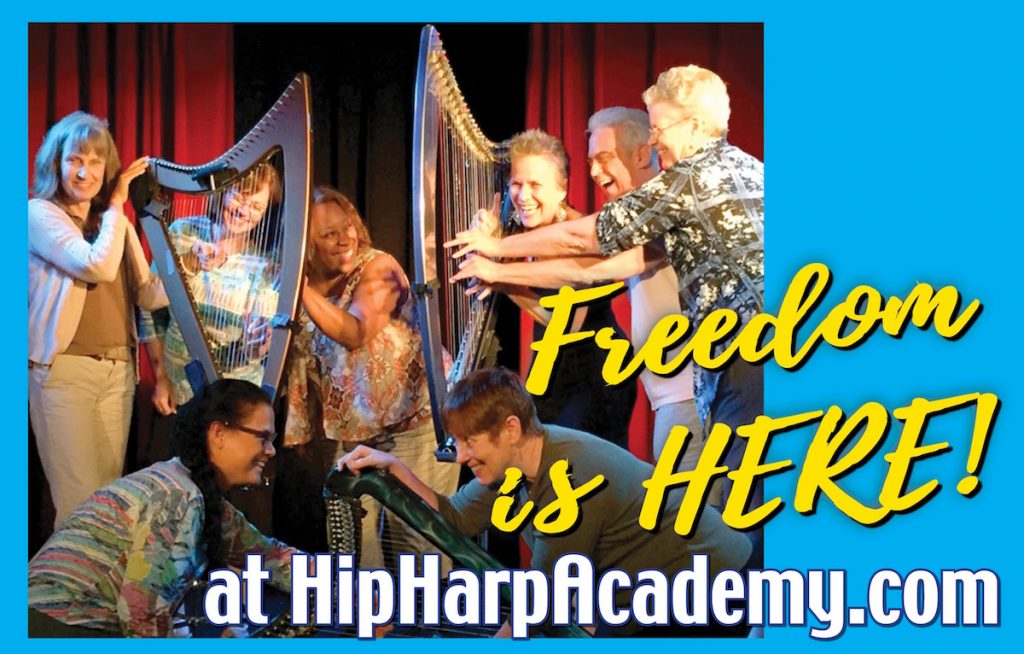
Join NOW and GET $400 OFF until Midnight Jul. 31
PROJECTS & PERFORMANCES:
FOR HARPISTS:
- Join Hip Harp Academy
- Harp Time Live (FREE Weekly Playalong)
- FREE Resources

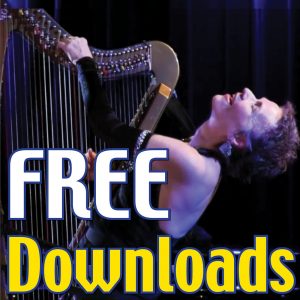
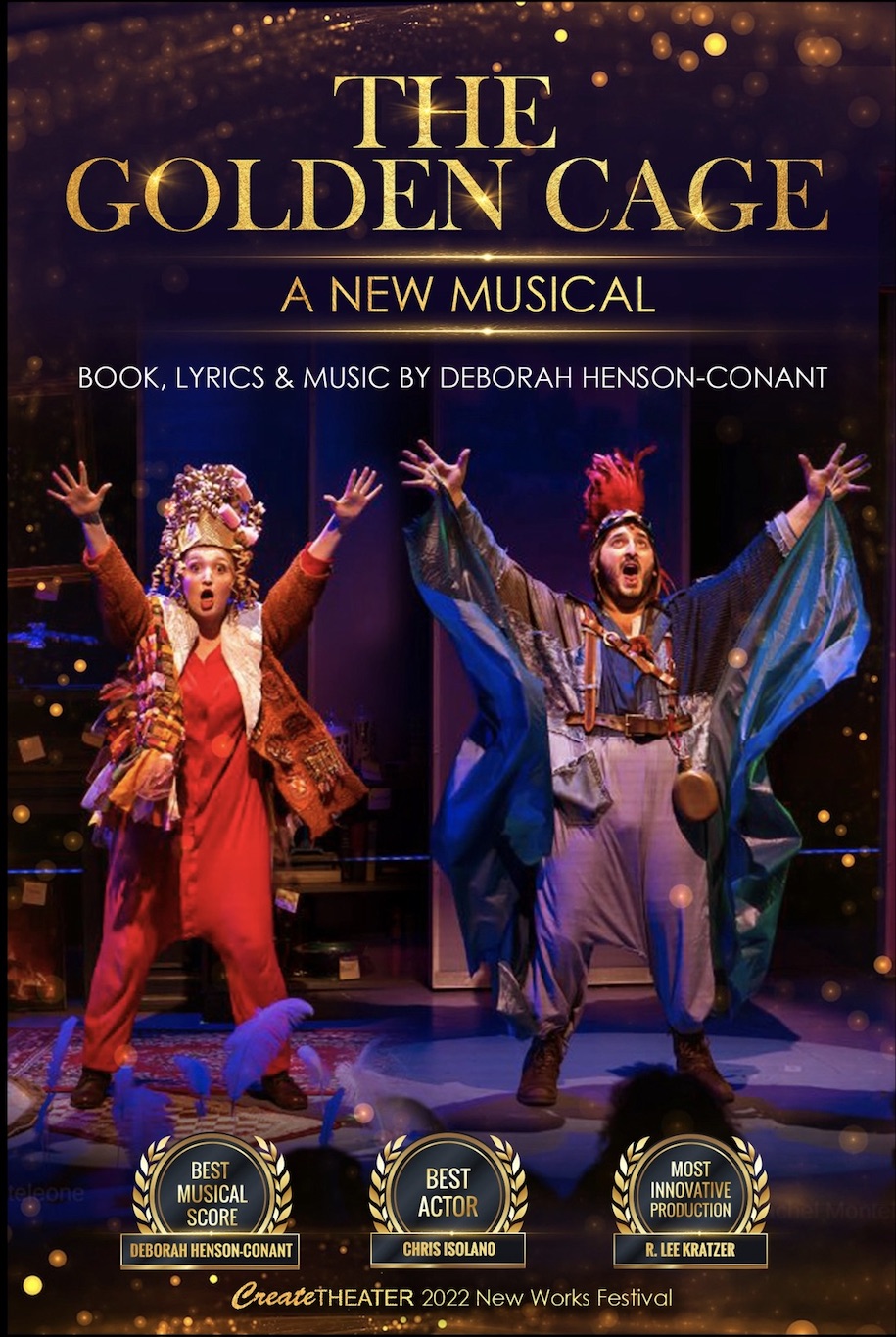
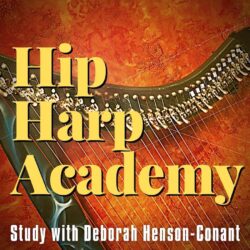
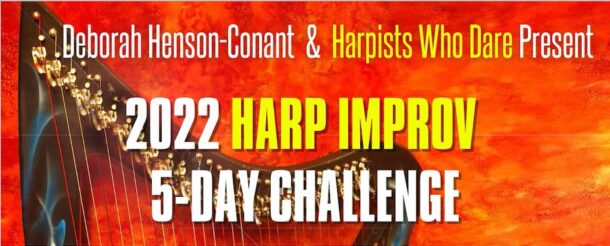
Join for Freebies, Stories & News
Join to get weekly-ish emails with stories, videos & events like concerts & classes
Yay! You should get my next newsletter within the next 7-10 days. I'm so happy we'll be in touch!
I won't ever share your email address with others - and you can unsubscribe anytime, tho most people say they really enjoy these weeklish emails.